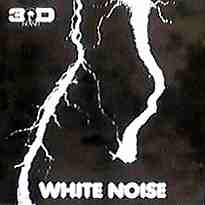

Production co-ordinator --David Vorhaus
Electronic sound realisation -- Delia Derbyshire, Brian Hodgson
Percussion -- Paul Lytton
Vocals -- John Whitman, Annie Bird, Val Shaw
Special Stereo Effects devised by David Vorhaus BSC.DIP.Elec
Sound base transfer co-ordinator: Trevor Wyatt
1) Love without Sound 2:57
(Derbyshire/Vorhaus)
Co-written by Delia Derbyshire, the first song by White Noise and
one that got them the Island deal, all string are double-bass parts played
by D.V. sped up to sound like violins, cellos and violas. John Whitman
sings the main vocal.
2) My Game of Loving 3:38
(Duncan/Vorhaus)
Lyrics were written by Georgina Duncan, Annie Bird sings throughout,
the track has an uncanny resemblence to American counterparts Donald Byrd
and the Field Hippies and the United States of America. Vorhaus had to
construct one 'electronic' orgy and after having lived with it for a bit,
combined it with the recording of a real orgy. What a drag that must have
been.
3) Here Come the Fleas 2:31
(McDonald/Vorhaus)
An obvious single choice, though never a single. Kenny Everett used
the first percussive break, after verse one, as a jingle on his radio programme.
Briean Hodgson plays the Carribean gentleman asking for the music to be
turned down as he can't hear his own steel band. Very Island Records. Co-Written
with John Renn-Mc-Donald.
4) Firebird 2:43
(Derbyshire/Vorhaus)
The second song recorded by White Noise, another co-write with Delia
Derbyshire. John Whitman sings and Lisa Pollack supplies backing vocals.
5) Your Hidden Dreams 4:25
(McDonald/Vorhaus)
The lyrics were printed on the sleeve as they were considered inaudible
(all that electronic wizardry you see)
6) The Visitations 11:45
(McDonald/Vorhaus)
Light out, headphones on -- a trip on a motorcycle to see a girlfriend
ends in a fatal accident. In true 'Truly Madly Deeply' fashion he visits
his beau but only for 'such a hopeless moment'. This took 3 months to recoed,
was co-writtem by John Renn-McDonald and became idolised as the heaviest
trip on the album. A triumph of sound and splicing tape.
7) The Black Mass: An Electric Storm in Hell
(White Noise)
Island Records are on the 'phone demanding a finished album and
you've seven minutes of tape left and only one day to fill it, what would
you do? Answer: the group-jam in a live performance. This was admittedly
inspired by Pink Floyd's 'Sauverful of Secrets'with ex-dentist Paul Lytton
on drum. Georgina Duncan wrote the lyris at the beginning of the track.
Welcome to the world of the frequency shifter, signal generator and azimuth co-ordinator. A world that existed before the dawn of the synthesizer, when a 'sample'was a length of recording tape delicately and skillfully spliced in place. The 1968 "White Noise -- An Electric Storm"LP became the holy grail amongst collectors of 'Science Dimension' music, a staple ingredient for lovers of cosmic electronic space-rock.
White Noise was really one David Vorhaus (b,sc,dip.elec) American born, son of a black-listed film director. He avoided the draft by coming to the UK. Later he became a post graduate doing an electronics degree at the Northern Poly whilst studying classical music playing the double bass. After having attended a lecture by the group Unit Delta Plus, Vorhaus was compelled to combine his love of music with his scientific background and start making his own music. At the time Unit Delta Plus were Brian Hodgson and Delie Derbyshire who were persuaded to collaborate with Vorhaus on his early recordings whilst they continued their day jobs at the BBC's radio phonic workshop, itself a shrine to new electronic music and birthplace of the famous Dr. Who theme. After recording two tracks on a six-revox set up all synchronised by one remote control, (i.e. the mains on/off switch), Vorhaus found himslef introduced by chance to Island Records' Chris Blackwell. Chris was so captivated by the white noise experience that he shunned their appeal for a one-off singles deal and demanded that they do a whole album of material. An instant cheque for £3,000 quenched their fears about not earning a quick buck through a hit single and our band of merry pranksters set about building theur own sonic laboratiry in London's Camden Town out of 'borrowed' gear, home made gizmos and equipment more assiciated with a scince lab than a recording studio. 'Songs' took ages to build, each note being a compilation of various tape edits painstakingly stuck together. After a year Island Records became nervous and demanded a conclusion in a matter of days which, luckily, White Noise managed to pull off. The album was released in a total vacuum. Vorhaus played no gigs and did no interviews. Word of mouth over many years caused this album to sell tens of thousands of records. Like stablemates Art and Nirvana, this album remained on catalogue deep into the seventies and became the hit of many a bedroom and sicth form commonroom. Five years after its release Vorhaus made a second album on Virgin and a third in 1980 for the Pulse label. He continues to make music, a good deal for film and television work, and threatens a new album for the nineties. One album per decade is hardly a Prince-like output but when the quality is this high does it really matter?
Original lightning sleeve was a screen print by an unknown art student. It was meant to be luminous when released but Island Records said 'NO' then. Island Records continue to say 'NO' unfortunately.
Original sleeve by Island Art
Re-issue package by Phil Smee at Waldo's Design & Dream Emporium.
Sleeve notes and 1992 beans spilt by Kemi Kally (art rock historian)
On a more technical note, the album features one of the most advanced
and unstable synthesizers of it's day.
The EMS VCS3.
If you want to hear the audio, buy the CD LC 0407 ... Or search
for the MP3 or MP2 files. They may be somewhere on the internet... search
for whitenoi1.mp2 ... whitenoi7.mp3
or something.